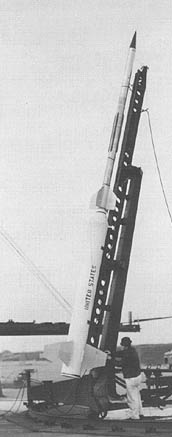 An American Nike-Cajun rocket. Rehbar-I was based on Nike-Cajun rockets. | |
| Function | Sounding Rocket |
|---|---|
| Manufacturer | SUPARCO NASA |
| Country of origin | Pakistan United States |
| Size | |
| Height | 7.70 m (130 km) |
| Diameter | 42 cm (42.45 cm) |
| Stages | 2 |
| Associated rockets | |
| Derivative work | Dragon Rocket Series, Shahpar Rocket Series |
| Launch history | |
| Status | Retired |
| Launch sites | Sonmiani Satellite Launch Center |
| Total launches | 4 |
| Success(es) | 4 |
| Failure(s) | None |
| Partial failure(s) | None |
| First flight | I: 7 June 1962 IIA: 11 June 1962 III: 18 March 1964 |
| Last flight | XX: 13 February 1969 XXIII: 7 April 1972 XXIV: 8 April 1972 |
| Type of passengers/cargo | Weather Observatory |
| Boosters (Rehbar-I) | |
| No. boosters | 2 |
| Engines | 1 Solid |
| Thrust | 246.3 kN (107,530 lbf) |
| Specific impulse | 3.0 sec |
| Burn time | 2.8 seconds |
| Propellant | Solid |
| Boosters | |
| No. boosters | 1 |
| Propellant | LOX/RP-1 |
| First stage | |
| Engines | 1 RS-58-OSA |
| Thrust | 249 kN |
| Specific impulse | 3 sec |
| Burn time | 2 seconds |
| Propellant | RP-1/LOX |
| Second stage Nike Cajun | |
| Engines | 2 RL-10A |
| Thrust | 147 kN (41,592 lbf) |
| Specific impulse | 4 sec |
| Burn time | 3 seconds |
| Propellant | LH2/LOX |
Rehbar is a series of sounding rockets launched into the upper atmosphere by Pakistan's Space and Upper Atmosphere Research Commission (SUPARCO). Rehbar-I was the first rocket launched by SUPARCO, on 7 June 1962.[1][2] Rehbar-I was a two-staged solid fuel rocket.
Various sounding rocket models were launched by Pakistan approximately 200 times between 1962 and 1972. Twenty-four of those flights were in the Rehbar series.[3][4] The Rehbar series of flights utilized no less than three and possibly four different sounding rockets. The rockets used were Centaure,[5] Judi-Dart,[6] Nike-Cajun,[7] and according to one source, Nike-Apache.[3][8] Other sounding rockets used by Pakistan were Dragon 2B,[9] Petrel,[10] and Skua.[4][11] Rehbar literally means "one who leads the way" in Urdu.
- ^ "SIPARCO History". Pakistan Space & Upper Atmosphere Research Commission. Archived from the original on 19 September 2015. Retrieved 11 August 2015.
- ^ "Pakistan's first rocket soars 80 miles high". Dawn. 8 June 1962.
- ^ a b "Sonmiani". Encyclopedia Astronautica. Archived from the original on 24 August 2015. Retrieved 11 August 2015.
- ^ a b "Pakistan". Encyclopedia Astronautica. Archived from the original on 5 October 2012. Retrieved 11 August 2015.
- ^ "Centaure". Encyclopedia Astronautica. Archived from the original on 19 October 2013. Retrieved 5 August 2015.
- ^ "Judy-Dart". Encyclopedia Astronautica. Archived from the original on 3 November 2013. Retrieved 5 August 2015.
- ^ "Nike Apache". Encyclopedia Astronautica. Archived from the original on 9 February 2014. Retrieved 5 August 2015.
- ^ "Nike Cajun". Encyclopedia Astronautica. Archived from the original on 9 February 2014. Retrieved 11 August 2015.
- ^ "Dragon 2B". Encyclopedia Astronautica. Archived from the original on 29 August 2010. Retrieved 11 August 2015.
- ^ "Petrel". Encyclopedia Astronautica. Archived from the original on 24 August 2015. Retrieved 5 August 2015.
- ^ "Skua". Encyclopedia Astronautica. Archived from the original on 24 August 2015. Retrieved 5 August 2015.